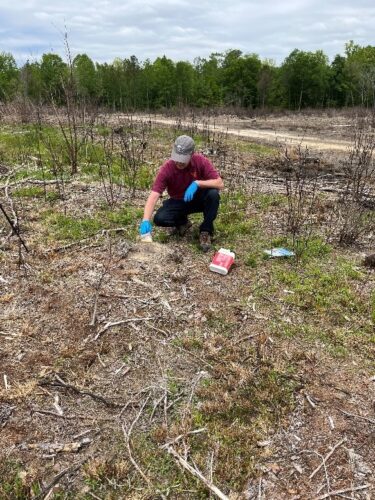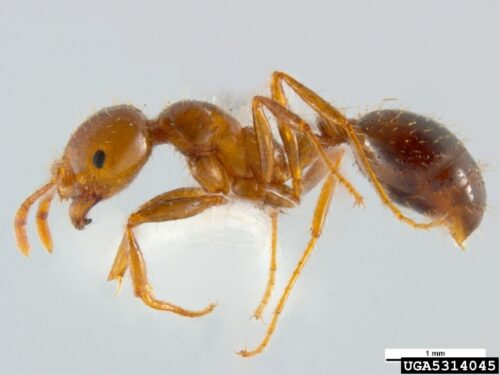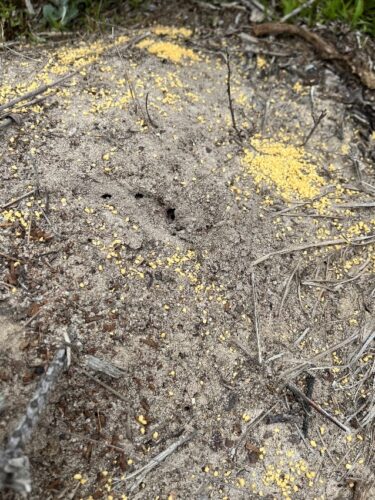Sounding the Fire (Ant) Alarm!
May 26, 2022 9:14 am

By Katlin Dewitt, DOF Forest Health Specialist
Can a fire alarm alert you to an invasive insect? Technically, no, but it seems an appropriate way to raise awareness about the red imported fire ant!
The red imported fire ant (RIFA) is native to central South America and was first detected in either Alabama or Florida between 1933 and 1945. In Virginia, this species was first detected in 1989, and so far, all infestations have been introduced from nursery or plant stock from infested areas, or through natural spread from nearby colonies. In 2009, a quarantine was issued for James City and York counties, as well as the cities of Chesapeake, Hampton, Newport News, Norfolk, Poquoson, Portsmouth, Suffolk, Virginia Beach, and Williamsburg. The most current map from 2019 shows the quarantine expanded to include the cities of Emporia and Franklin as well as the counties of Brunswick, Isle of Wight, Greensville, Mecklenburg, and Southampton.
What is concerning about these ants? There are a number of factors, but a major one is the painful sting they issue when disturbed. Unlike some ants that irritate with formic acid, RIFA sting with venom and use their mandibles to grab hold of the skin and bite while they sting. These stings pose a large risk to farm and forestry workers that could be in RIFA areas and unknowingly step on a mound. The other major concern is that they can be easily transported on equipment that picks up loose soil or is parked in infested areas. This allows for easy transport to new locations as equipment moves from one job to another.

Fire ants are not large; workers range from 1/16 to 1/4 inch long. (Photo credit: Pest & Disease Image Library, Bugwood.org)
RIFA prefers to settle in areas that won’t flood and have ample sunlight. Cutovers, areas along roadsides and logging decks are prime real estate for these ant colonies. These insects have single-queen colonies, meaning that there is only one queen per mound and thousands of workers that feed and protect her. They are not very active in the winter and become more active as spring rolls around. Once temperatures are above 73 degrees Fahrenheit, flight activity begins as new queens move to establish their colonies. Rapid growth in colony size occurs throughout the summer months. One colony can last three to four years.
There are treatment options available to help control RIFA colonies. One option is a bait treatment which is applied when worker ants are actively looking for food, usually in the late afternoon or early evening. The other option is a mound treatment with a contact insecticide. In both cases, follow the label! If you over-apply the bait treatment, it can actually act as a repellent, and the ants won’t take it down into the colony. These treatments are very effective; just one granule getting to the queen will end the colony.
- Treating a RIFA mound
- Bait placed near mound
It is important to ensure that you have RIFA before applying the treatment. There is a look-alike species, the Alleghany mound ant, and these treatments are not labeled for control of this species. If you are unsure, collect a few ant specimens in dirt and take them to your local extension office for confirmation.
What does the spread of fire ants mean for the forestry and logging community? In a nutshell, when in the quarantine area, pay attention to where you are stepping and working – fire ant stings hurt! Additionally, when moving logs or equipment out of the quarantine area, you must ensure that they are free of RIFA. If loose, uncompacted soil is attached, use a pressure washer or hot water to clean equipment prior to moving to a new location. If you have any questions about complying with the quarantine, please reach out to VDACS Office of Plant Industry Services to learn more.
Tags: Forest Health Impacts, Insects, Invasive Species
Category: Forest Health

